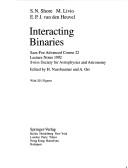| Listing 1 - 5 of 5 |
Sort by
|
Book
ISBN: 0691239266 9780691239262 9780691179087 9780691179070 Year: 2022 Publisher: Princeton : Princeton University Press,
Abstract | Keywords | Export | Availability | Bookmark
 Loading...
Loading...Choose an application
- Reference Manager
- EndNote
- RefWorks (Direct export to RefWorks)
"When we think about stars, many of us imagine single points of light. Yet in fact, nearly all stars are members of binary systems - coupled systems in which two gravitationally bound stars orbit around a common center of mass - and thus they play a central role in modern astrophysics. The evolution of binary stars over time leads to the production of pairs of compact objects in tight orbits (such as double neutron stars and double black holes), and to the formation of different types of violent cosmic events, such as novae, supernova explosions, gamma-ray bursts, mass transfer and accretion processes in X-ray binaries, and the formation of exotic millisecond pulsars. In some cases, the binary systems terminate as spectacular collisions between neutron stars and/or black holes, leading to the emission of powerful gravitational waves (as recently detected by LIGO). The coming decade is expected to reveal many discoveries of binary compact systems, including their progenitors and merger remnants, from major observational instruments, making the need for a modern text on the physics of binary star evolution acute. In this book, students and researchers will learn about the physics of binary interactions, from stellar birth to compact objects, and relate this knowledge to the latest observations. They will also learn about stellar structure and evolution, and detailed binary interactions covering a broad range of phenomena, including mass transfer and orbital evolution, formation and accretion onto compact objects (white dwarfs, neutron stars and black holes) and their observational properties. Exercises following each main chapter will also be provided"--
Double stars --- Étoiles doubles --- Evolution. --- Évolution. --- Evolution --- Étoiles doubles. --- Évolution stellaire. --- Stars
Book
ISBN: 9781316629253 9781316823163 Year: 2019 Publisher: Cambridge Cambridge University Press
Abstract | Keywords | Export | Availability | Bookmark
 Loading...
Loading...Choose an application
- Reference Manager
- EndNote
- RefWorks (Direct export to RefWorks)
Modern telescopes of even modest aperture can show thousands of double stars. Many are faint and unremarkable but hundreds are worth searching out. Veteran double-star observer Bob Argyle and his co-authors take a close-up look at their selection of 175 of the night sky's most interesting double and multiple stars. The history of each system is laid out from the original discovery to what we know at the present time about the stars. Wide-field finder charts are presented for each system along with plots of the apparent orbits and predicted future positions for the orbital systems. Recent measurements of each system are included which will help you to decide whether they can be seen in your telescope, as well as giving advice on the aperture needed. Double star observers of all levels of experience will treasure the level of detail in this guide to these jewels of the night sky.
Double stars --- Double stars --- Astronomy --- Amateur astronomy. --- Étoiles doubles. --- Étoiles doubles. --- Astronomie.


ISBN: 3540570144 0387570144 Year: 1994 Publisher: Berlin ; New York ; London [etc.] : Springer-Verlag,
Abstract | Keywords | Export | Availability | Bookmark
 Loading...
Loading...Choose an application
- Reference Manager
- EndNote
- RefWorks (Direct export to RefWorks)
Observational and theoretical issues of interacting binaries was the topic of the 22nd of the renowned Advanced Course of the Swiss Society for Astrophysics and Astronomy. The three contributions by outstanding experts collected in this book deal with observations, symbiotic stars, cataclysmic variables, massive binaries and X-ray binaries thus filling a gap in the existing literature. The articles review the state of the art and address both students and researchers. The accessible and didactic approach makes the book a valuable source for future work on interacting binary stars whose study is essential for a better understandingof stellar evolution.
Double stars --- Astrophysics --- Étoiles doubles. --- Étoiles variables cataclysmiques. --- Étoiles doubles. --- Étoiles variables cataclysmiques.
Book
Abstract | Keywords | Export | Availability | Bookmark
 Loading...
Loading...Choose an application
- Reference Manager
- EndNote
- RefWorks (Direct export to RefWorks)
X-ray binaries. --- X-ray astronomy. --- Astronomie des rayons X. --- Étoiles doubles. --- Étoiles doubles.
Book
Year: 1984 Publisher: Jakarta : Tira Pustaka,
Abstract | Keywords | Export | Availability | Bookmark
 Loading...
Loading...Choose an application
- Reference Manager
- EndNote
- RefWorks (Direct export to RefWorks)
Galaxies. --- Étoiles doubles. --- Pulsars. --- Galaxies --- Double stars --- Pulsars --- Étoiles doubles.
| Listing 1 - 5 of 5 |
Sort by
|

 Search
Search Feedback
Feedback About UniCat
About UniCat  Help
Help News
News